### 实验环境搭建
1. **VLAN划分与VRPR配置** - 为了满足需求,我们需要在两台交换机上划分VLAN。SW1上划分VLAN10和VLAN20,分别对应PC1和PC2。SW2作为三层交换机,同样需要划分VLAN10、VLAN20和一个额外的VLAN100用于连接SW1和R1。 - 配置VRPR,使得VLAN10的Master为SW1,VLAN20的Master为SW2,确保设备间的故障切换。
2. **设备互联** - SW1的接口e0/0/1和e0/0/2分别接入VLAN10和VLAN20,接口g0/0/1和g0/0/2设置为Trunk模式,允许所有VLAN通过。 - SW2的接口g0/0/1设置为trunk模式,连接SW1的g0/0/2,接口g0/0/2连接到R1的g0/0/0。 - SW3配置与SW2类似,但优先级设置更高,确保在SW2故障时自动接管VLAN20的Master角色。
3. **路由器配置** - AR1作为核心路由器,需要配置三个接口的ip地址,并设置静态路由指向SW2和SW3的VLAN接口,实现与PC1和PC2的通信。 - AR2连接到AR1的g0/0/0接口,并设置静态路由指向AR1,实现网络互通。 - AR3作为边缘路由器,需要配置三个接口的IP地址,并设置默认路由指向AR2的g0/0/0接口。
4. **NAT与EasyIP配置** - 为了让Client1能够访问外网,我们需要在AR1上配置EasyIP,将内部网络地址映射到AR1的外网接口地址。 - 为了让Client1能够登录FTP服务器,我们需要在AR3上配置NAT-server,将内部FTP服务器的地址映射到AR3的外网接口地址。
### 验证实验结果
1. **VLAN划分与VRPR验证** - 断开SW2的线路,观察SW3是否成功接管VLAN20的Master角色,确保故障切换功能正常。 - 断开SW3的线路,观察SW2是否成功接管VLAN20的Master角色,确保故障切换功能正常。
2. **网络连通性验证** - 使用PC1 ping PC3,验证网络连通性是否正常。 - 使用Client1访问外网,验证EasyIP配置是否正确。
3. **FTP登录验证** - 在AR2上使用FTP服务器的公网地址尝试登录,验证NAT-server配置是否正确。 - 在Client1上尝试登录FTP服务器,验证网络访问是否正常。
通过以上步骤,我们可以搭建一个稳定可靠的网络环境,满足实验的各项需求。

实验操作

实验要求:
1、需求VRRP 正常情况下VLAN10的Master为SW1;VLAN20的Master为SW2
2、PC1ping通PC3
3、使用Easy Ip进行转换使得Client1能够使用R1的g0/0/2的IP访问外网
4、使用NAT-server使得Client1访问server的Web服务,并且能够使用R3的g0/0/0接口进行登陆FTP。
sw1配置(二层交换机)
配置思路:
与计算机连接的接口模式为access模式,与三层交换机相连接的为trunk,客户端和pc1都为vlan 10,pc2位vlan 20.且上行两个接口都至少需要vlan 10和vlan 20允许通过,因为三层交换机互为主备,所以两边都要可以实现通过。
sys#进入系统模式 En
te
rsystemview,
returnuserview
withCtrl+Z. [Huawei]sysnameSW1#修改名称 [SW1]undoinfo-centerenable#取消提示
Info:Informationcenterisdisabled. [SW1]vlanbatch
10
20#创建vlan
10
20
Info:Thisopera
tionmaytake
afewseconds.Pleasew
ait
foramoment...done. [SW1]inte0/
0/
1#进入接口e0/
0/
1 [SW1-
Ethernet0/
0/
1]portlink-typeAccess#设置为access模式 [SW1-Ethernet0/
0/
1]port
defaultvlan
10#默认vlan为
10 [SW1-Ethernet0/
0/
1]undoshutdown#开启
端口
Info:InterfaceEthernet0/
0/
1isnotshutdown. [SW1-Ethernet0/
0/
1]inte0/
0/
2#进入接口e0/
0/
2 [SW1-Ethernet0/
0/
2]portlink-typeaccess#设置为access模式 [SW1-Ethernet0/
0/
2]port
defaultvlan
20#默认vlan为
20 [SW1-Ethernet0/
0/
2]undoshutdown#开启端口
Info:InterfaceEthernet0/
0/
2isnotshutdown. [SW1-Ethernet0/
0/
2]inte0/
0/
3#进入接口e0/
0/
3 [SW1-Ethernet0/
0/
3]portlink-typeaccess#设置为access模式 [SW1-Ethernet0/
0/
3]port
defaultvlan
10#设置默认vlan [SW1-Ethernet0/
0/
3]undoshutdown#开启端口
Info:InterfaceEthernet0/
0/
3isnotshutdown. [SW1-Ethernet0/
0/
3]intg0/
0/
1#进入g0/
0/
1接口 [SW1-GigabitEthernet0/
0/
1]portlink-typetrunk#设置trunk模式 [SW1-GigabitEthernet0/
0/
1]porttrunkallow-passvlanall#设置所有vlan允许通过 [SW1-GigabitEthernet0/
0/
1]undoshutdown#开启端口
Info:InterfaceGigabitEthernet0/
0/
1isnotshutdown. [SW1-GigabitEthernet0/
0/
1]intg0/
0/
2#进入g0/
0/
2接口 [SW1-GigabitEthernet0/
0/
2]portlink-typetrunk#设置trunk模式 [SW1-GigabitEthernet0/
0/
2]porttrunkallow-passvlanall#设置所有vlan允许通过 [SW1-GigabitEthernet0/
0/
2]undoshutdown#开启端口
Info:InterfaceGigabitEthernet0/
0/
2isnotshutdown. [SW1-GigabitEthernet0/
0/
2]q
SW2配置(三层交换机)
配置思路:
三层交换机具有路由器和交换的功能,但是接口无法直接设置IP,所以需要通过创建Vlan来设置虚拟ip,设置好虚拟ip之后然后再在实际接口中允许所创建的vlan通过。因为sw2是pc1的主链路,所以在设置VRRP时,需要将它的优先级设置高一点,pc2在sw2上的链路是备链路,所以优先级暂不设置,默认100。因为三层交换机与R1不在同一网段,所以需要设置默认路由可以实现与路由器AR1的通信。
sys#进入系统模式 Entersystemview,
returnuserview
withCtrl+Z. [Huawei]sysnameSW2#修改名称 [SW2]undoinfo-centerenable#关闭提示
Info:Informationcenterisdisabled. [SW2]vlanbatch
10
20
100#创建vlan
Info:Thisoperationmaytakeafewseconds.Pleasewait
foramoment...done. [SW2]intvlanif
10#进入虚拟接口vlanif
10 [SW2-Vlanif10]ip
add
192.168
.10
.10
24#设置接口ip [SW2-Vlanif10]vrrpvrid
1virtual-ip
192.168
.10
.1#设置虚拟ip [SW2-Vlanif10]vrrpvrid
1priority
120#设置优先级
120 [SW2-Vlanif10]vrrpvrid
1preempt-modetimerdelay
5#设置抢占时间
5s [SW2-Vlanif10]vrrpvrid
1trackintg0/
0/
2reduced
30#监控上行接口 [SW2-Vlanif10]vrrpvrid
1trackintg0/
0/
1reduced
30#监控下行接口 [SW2-Vlanif10]dith#查看所有配置 # interfaceVlanif10 iPaddress
192.168
.10
.10
255.255
.255
.0 vrrpvrid
1virtual-ip
192.168
.10
.1 vrrpvrid
1priority
120 vrrpvrid
1preempt-modetimerdelay
5 vrrpvrid
1trackinte
rfaceGigabitEthernet0/
0/
2reduced
30 vrrpvrid
1trackinterfaceGigabitEthernet0/
0/
1reduced
30 #
return [SW2-Vlanif10]q#返回 [SW2]intvlanif
20#进入虚拟接口vlanif
20 [SW2-Vlanif20]ipadd
192.168
.20
.20
24#配置接口ip [SW2-Vlanif20]vrrpvrid
2virtual-ip
192.168
.20
.1#配置虚拟ip [SW2-Vlanif20]dith#查看配置 # interfaceVlanif20 ipaddress
192.168
.20
.20
255.255
.255
.0 vrrpvrid
2virtual-ip
192.168
.20
.1 #
return [SW2-Vlanif20]q#返回 [SW2]intg0/
0/
1#进入接口g0/
0/
1 [SW2-GigabitEthernet0/
0/
1]portlink-typetrunk#配置trunk模式 [SW2-GigabitEthernet0/
0/
1]porttrunkallow-passvlanall#设置所有vlan允许通过 [SW2-GigabitEthernet0/
0/
1]dith#查看配置 # interfaceGigabitEthernet0/
0/
1 portlink-typetrunk porttrunkallow-passvlan
2to
4094 #
return [SW2-GigabitEthernet0/
0/
1]undoshutdown#启动接口
Info:InterfaceGigabitEthernet0/
0/
1isnotshutdown. [SW2-GigabitEthernet0/
0/
1]q#返回 [SW2]intvlanif
100#进入虚拟接口vlanif100 [SW2-Vlanif100]ipadd
10.0
.0
.10
24#设置接口ip [SW2-Vlanif100]q#返回 [SW2]intg0/
0/
2#进入g0/
0/
2接口 [SW2-GigabitEthernet0/
0/
2]portlink-typeaccess#设置access模式 [SW2-GigabitEthernet0/
0/
2]port
defaultvlan
100#设置默认vlan
100 [SW2-GigabitEthernet0/
0/
2]undoshutdown#开启接口
Info:InterfaceGigabitEthernet0/
0/
2isnotshutdown. [SW2-GigabitEthernet0/
0/
2]dith#查看配置 # interfaceGigabitEthernet0/
0/
2 portlink-typeaccess port
defaultvlan
100 #
return [SW2-GigabitEthernet0/
0/
2]q#返回 [SW2]iproute-
static
0.0
.0
.0
0.0
.0
.0
10.0
.0
.1#配置默认路由
SW3配置(三层交换机)
三层交换机具有路由器和交换的功能,但是接口无法直接设置ip,所以需要通过创建Vlan来设置虚拟ip,设置好虚拟ip之后然后再在实际接口中允许所创建的vlan通过。因为sw3是pc2的主链路,所以在设置vrrp时,需要将它的优先级设置高一点,同理,pc1在sw3上的链路是备链路,所有优先级暂不设置,默认100。最后设置一个默认路由器,因为三层交换机与R1不在同一网段,所以设置默认路由可以实现与路由器AR1的通信。
sys#进入系统模式 Entersystemview,
returnuserview
withCtrl+Z. [Huawei]sysnameSW3#修改名称 [SW3]undoinfo-centerenable#关闭提示
Info:Informationcenterisdisabled. [SW3]vlanbatch
10
20
100#创建vlan
10
20
100
Info:Thisoperationmaytakeafewseconds.Pleasewait
foramoment...done. [SW3]intvlanif
10#进入虚拟接口vlanif
10 [SW3-Vlanif10]ipadd
192.168
.10
.20
24#设置接口ip [SW3-Vlanif10]vrrpvrid
1virtual-ip
192.168
.10
.1#设置虚拟ip [SW3-Vlanif10]dith#查看接口 # interfaceVlanif10 ipaddress
192.168
.10
.20
255.255
.255
.0 vrrpvrid
1virtual-ip
192.168
.10
.1 #
return [SW3-Vlanif10]q#返回 [SW3]intvlanif
20#进入虚拟接口vlanif
20 [SW3-Vlanif20]ipadd
192.168
.20
.10
24#设置接口ip [SW3-Vlanif20]vrrpvrid
2virtual-ip
192.168
.20
.1#设置虚拟ip [SW3-Vlanif20]vrrpvrid
2priority
120#设置优先级
120 [SW3-Vlanif20]vrrpvrid
2preempt-modetimerdelay
5#设置抢占时间
5s [SW3-Vlanif20]vrrpvrid
2trackintg0/
0/
2reduced
30#监控上行接口 [SW3-Vlanif20]vrrpvrid
2trackintg0/
0/
1reduced
30#监控下行接口 [SW3-Vlanif20]dith#查看命令 # interfaceVlanif20 ipaddress
192.168
.20
.20
255.255
.255
.0 vrrpvrid
2virtual-ip
192.168
.20
.1 vrrpvrid
2priority
120 vrrpvrid
2preempt-modetimerdelay
5 vrrpvrid
2trackinterfaceGigabitEthernet0/
0/
2reduced
30 vrrpvrid
2trackinterfaceGigabitEthernet0/
0/
1reduced
30 #
return [SW3-Vlanif20]q#返回 [SW3]intvlanif
100#进入虚拟接口vlanif
100 [SW3-Vlanif100]ipadd
11.0
.0
.20
24#设置接口ip [SW3]intg0/
0/
2#进入接口g0/
0/
2 [SW3-GigabitEthernet0/
0/
2]portlink-typeaccess#设置access模式 [SW3-GigabitEthernet0/
0/
2]port
defaultvlan
100#默认vlan100 [SW3-GigabitEthernet0/
0/
2]undoshutdown#开启接口
Info:InterfaceGigabitEthernet0/
0/
2isnotshutdown. [SW3-GigabitEthernet0/
0/
2]dith#查看配置 # interfaceGigabitEthernet0/
0/
2 portlink-typeaccess port
defaultvlan
100 #
return [SW3-GigabitEthernet0/
0/
2]intg0/
0/
1进入g0/
0/
1接口 [SW3-GigabitEthernet0/
0/
1]portlink-typetrunk#设置trunk模式 [SW3-GigabitEthernet0/
0/
1]porttrunkallow-passvlanall#设置允许所有vlan通过 [SW3-GigabitEthernet0/
0/
1]undoshutdown#开启端口
Info:InterfaceGigabitEthernet0/
0/
1isnotshutdown. [SW3-GigabitEthernet0/
0/
1]dith#查看端口 # interfaceGigabitEthernet0/
0/
1 portlink-typetrunk porttrunkallow-passvlan
2to
4094 #
return [SW3-GigabitEthernet0/
0/
1]q#返回 [SW3]iproute-
static
0.0
.0
.0
0.0
.0
.0
11.0
.0
.1#设置默认路由
AR1设置(路由器)
配置思路:
根据接口IP设置好各个的接口ip地址,然后启动,就开始配置静态路由,首先先配置往下的静态路由,因为根三层交换机不在同一网段,先配置往PC1的主线路sw2的静态路由,在配置往PC2的备线路sw3的浮动路由,然后先配置往PC2的主线路SW2的静态路由器,再配置往PC2备线路SW1的浮动路由,以上配置好后,再配置往右侧的静态路由,一个指向pc3,一个指向server1。然后配置结束。
sys#进入系统模式 Entersystemview,
returnuserview
withCtrl+Z. [Huawei]sysnameR1#修改名称R1 [R1]undoinfo-centerenable#关闭提示
Info:Informationcenterisdisabled. [R1]intg0/
0/
0#进入接口g0/
0/
0 [R1-GigabitEthernet0/
0/
0]ipadd
11.0
.0
.1
24#设置接口ip [R1-GigabitEthernet0/
0/
0]undoshutdown#开启接口
Info:InterfaceGigabitEthernet0/
0/
0isnotshutdown. [R1-GigabitEthernet0/
0/
0]intg0/
0/
1#进入接口g0/
0/
1 [R1-GigabitEthernet0/
0/
1]ipadd
10.0
.0
.1
24#设置接口ip [R1-GigabitEthernet0/
0/
1]undoshutdown#开启端口
Info:InterfaceGigabitEthernet0/
0/
1isnotshutdown. [R1-GigabitEthernet0/
0/
1]intg0/
0/
2#进入接口g0/
0/
2 [R1-GigabitEthernet0/
0/
2]ipadd
12.0
.0
.1
24#设置接口ip [R1-GigabitEthernet0/
0/
2]undoshutdown#开启端口
Info:InterfaceGigabitEthernet0/
0/
2isnotshutdown. #设置静态路由 [R1]iproute-
static
192.168
.10
.0
255.255
.255
.0
10.0
.0
.10 #目标网段:
192.168
.10
.0下一跳地址:
10.0
.0
.10 [R1]iproute-
static
192.168
.10
.0
255.255
.255
.0
11.0
.0
.20preference
70 #目标网段:
192.168
.10
.0下一跳地址:
11.0
.0
.20(浮动路由器,当PC1主线路端开后启用) [R1]iproute-
static
192.168
.20
.0
255.255
.255
.0
11.0
.0
.20 #目标网段:
192.168
.20
.0下一跳地址:
11.0
.0
.20 [R1]iproute-
static
192.168
.20
.0
255.255
.255
.0
10.0
.0
.10preference
70 #目标网段:
192.168
.20
.0下一跳地址:
10.0
.0
.10(浮动路由器,当PC2主线路端开后启用) [R1]iproute-
static
192.168
.100
.0
255.255
.255
.0
12.0
.0
.2 #目标网段:
192.168
.100
.0下一跳地址:
12.0
.0
.2 [R1]iproute-
static
192.168
.200
.0
255.255
.255
.0
12.0
.0
.2 #目标网段:
192.168
.200
.0下一跳地址:
12.0
.0
.2
AR2配置(路由器)
配置思路:
首先进入接口配合ip地址,启动接口,然后配置静态路由,首先配置往左侧的两台静态路由,再配置往右侧的两条静态路由。
sys#进入系统模式 Entersystemview,
returnuserview
withCtrl+Z. [Huawei]sysnameR2#修改名称 [R2]undoinfo-centerenable#关闭提示
Info:Informationcenterisdisabled. [R2]intg0/
0/
0#进入接口g0/
0/
0 [R2-GigabitEthernet0/
0/
0]ipadd
12.0
.0
.2
24#配置IP地址 [R2-GigabitEthernet0/
0/
0]undoshutdown#开启接口
Info:InterfaceGigabitEthernet0/
0/
0isnotshutdown. [R2-GigabitEthernet0/
0/
0]intg0/
0/
1#进入接口g0/
0/
1 [R2-GigabitEthernet0/
0/
1]ipadd
23.0
.0
.1
24#配置ip地址 [R2-GigabitEthernet0/
0/
1]undoshutdown#开启接口
Info:InterfaceGigabitEthernet0/
0/
1isnotshutdown. #配置静态路由 [R2]iproute-
static
192.168
.10
.0
255.255
.255
.0
12.0
.0
.1 #目的地址
192.168
.10
.0下一跳地址:
12.0
.0
.1 [R2]iproute-
static
192.168
.20
.0
255.255
.255
.0
12.0
.0
.1 #目的地址
192.168
.20
.0下一跳地址:
12.0
.0
.1 [R2]iproute-
static
192.168
.100
.0
255.255
.255
.0
23.0
.0
.2 #目的地址
192.168
.100
.0下一跳地址:
23.0
.0
.2 [R2]iproute-
static
192.168
.200
.0
255.255
.255
.0
23.0
.0
.2 #目的地址
192.168
.200
.0下一跳地址:
23.0
.0
.2
AR3配置(路由器)
配置思路:
进入各个接口将接口ip配置然后启动,配置静态路由只需要配置默认路由就行,因为它现在处于末梢网络,只有一个出口,所以完全可以配置默认路由器。
sys#进入系统模式 Entersystemview,
returnuserview
withCtrl+Z. [Huawei]sysnameR3#修改名称 [R3]undoinfo-centerenable#关闭提示
Info:Informationcenterisdisabled. [R3]intg0/
0/
0#进入接口g0/
0/
0 [R3-GigabitEthernet0/
0/
0]ipadd
23.0
.0
.2
24#配置接口ip [R3-GigabitEthernet0/
0/
0]undoshutdown#启动接口
Info:InterfaceGigabitEthernet0/
0/
0isnotshutdown. [R3-GigabitEthernet0/
0/
0]q#返回 [R3]intg0/
0/
1#进入接口g0/
0/
1 [R3-GigabitEthernet0/
0/
1]ipadd
192.168
.100
.1
24#配置接口ip [R3-GigabitEthernet0/
0/
1]undoshutdown#开启接口
Info:InterfaceGigabitEthernet0/
0/
1isnotshutdown. [R3-GigabitEthernet0/
0/
1]intg0/
0/
2#进入接口g0/
0/
2 [R3-GigabitEthernet0/
0/
2]ipadd
192.168
.200
.1
24#配置接口ip [R3-GigabitEthernet0/
0/
2]undoshutdown#开启接口 配置静态路由 [R3]iproute-
static
0.0
.0
.0
0.0
.0
.0
23.0
.0
.1 #配置一条默认路由下一跳
23.0
.0
.1
至目前为止,第一和第二个需求已完成,下面进行验证
第一个需求:
正常情况下线路这样走:
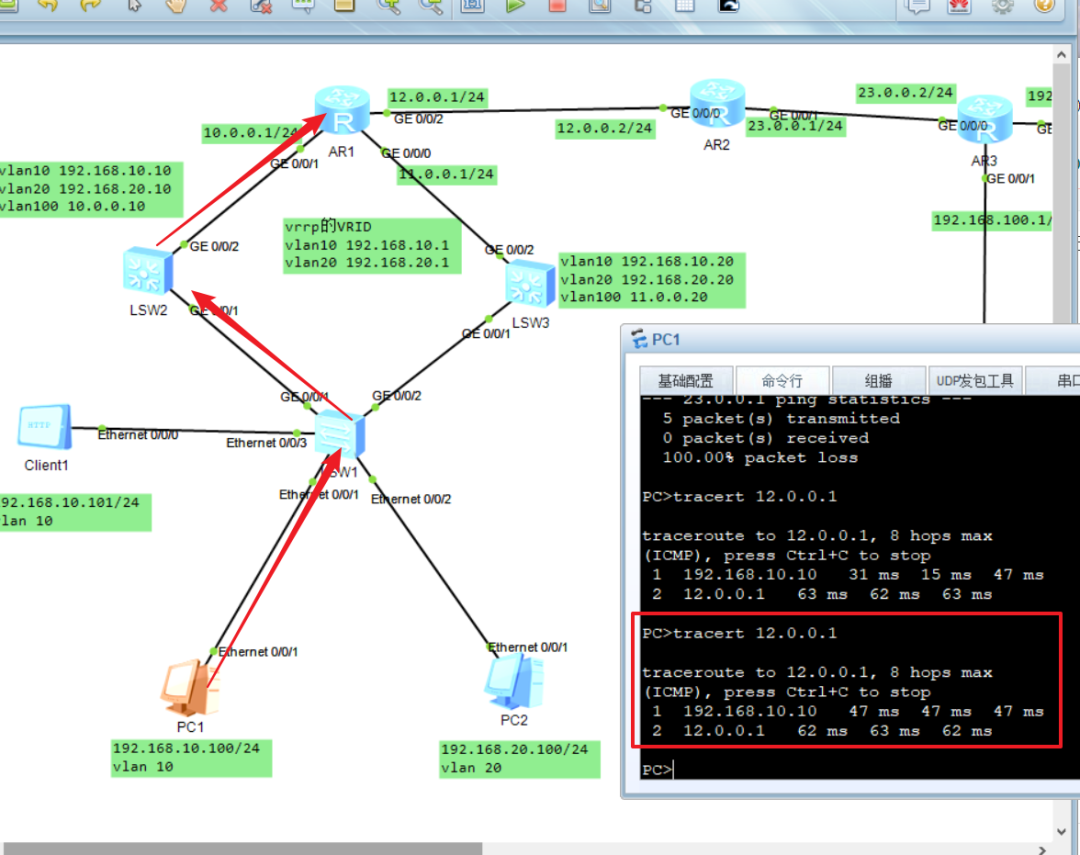
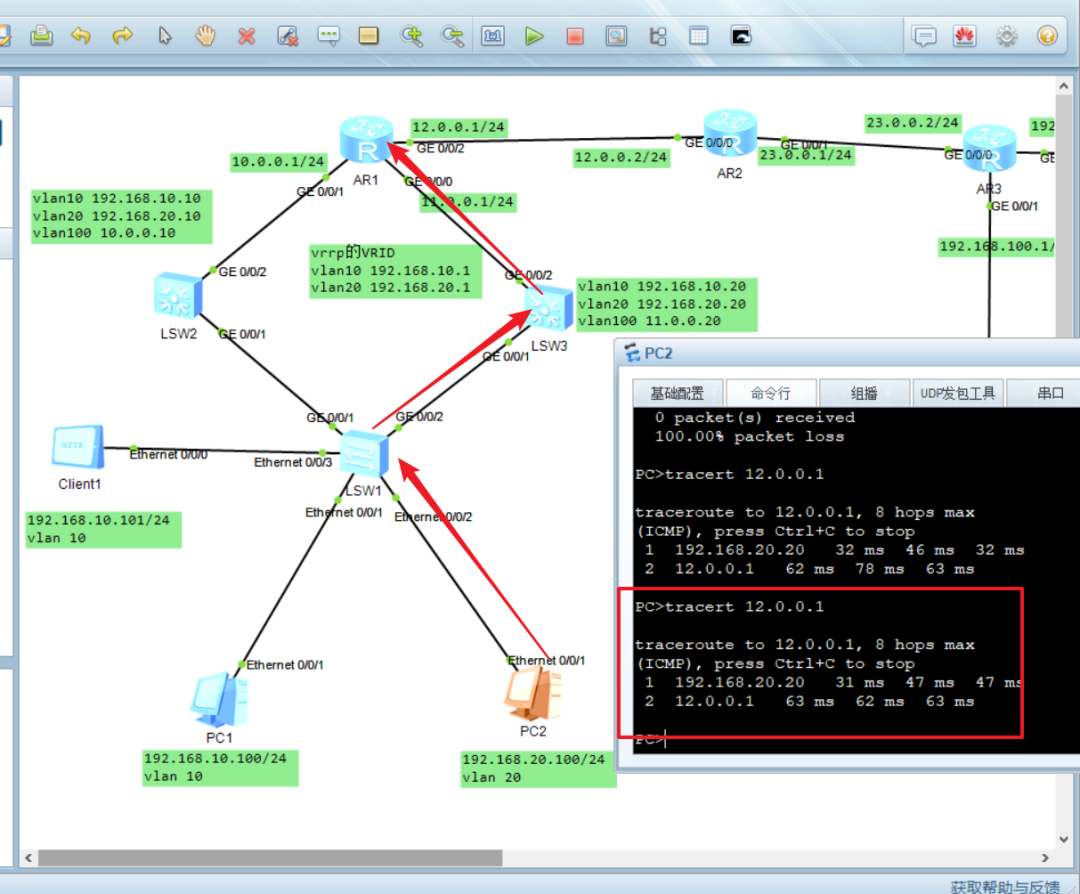
现将SW2线路断开,SW3抢占成功
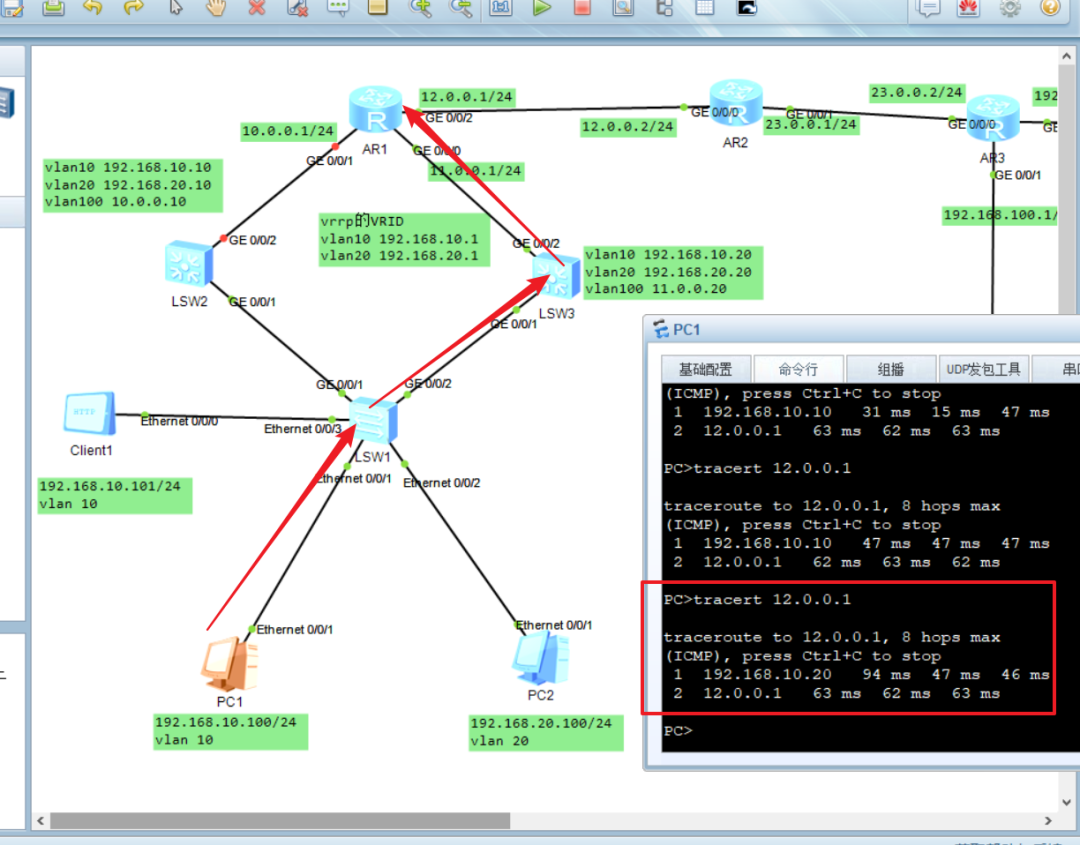
现将SW3线路切断,SW2抢占成功

第二需求:PC1 ping通 PC3
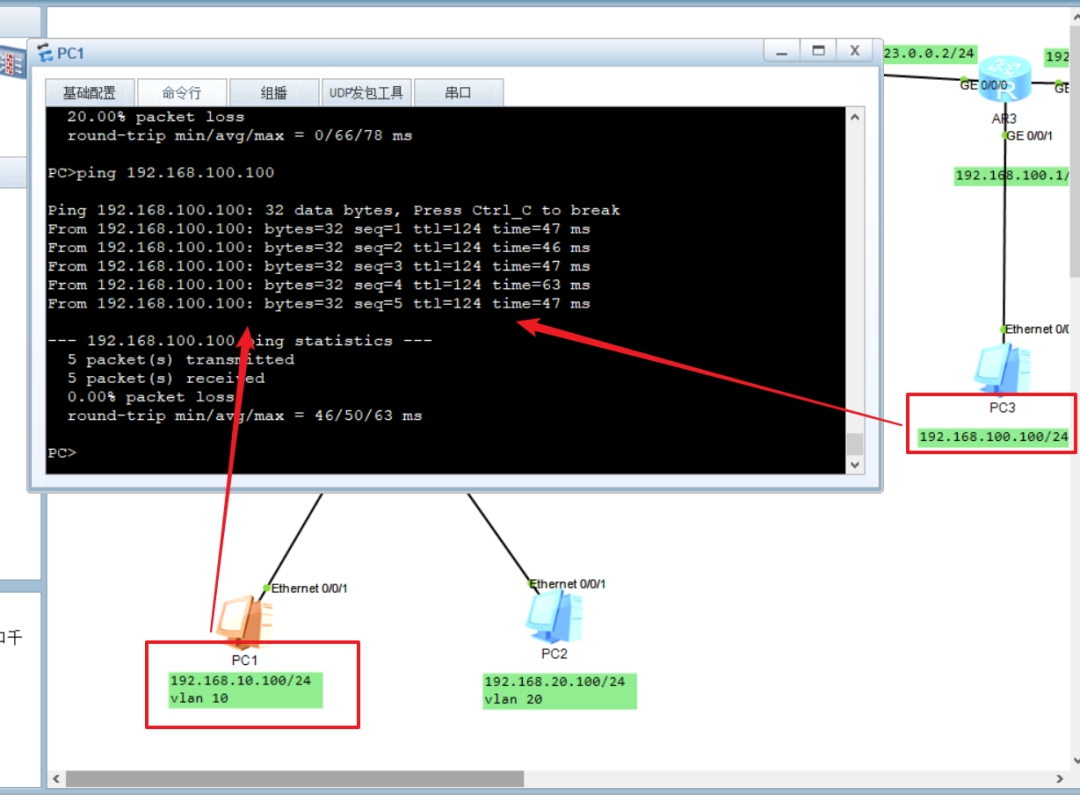
第三个和第四个还需要配置。
第三个配置:
R1配置
配置思路:Easyip配置为 将多个内网转换为一个接口外网地址,首先创建acl来进行设置哪个能否通过,然后再进入接口中映射。
sys#进入系统 Entersystemview,
returnuserview
withCtrl+Z. [R1]acl
2000#创建acl
2000 [R1-acl-b
ASIC
-2000]rulepermitsource
192.168
.10
.0
0.0
.0
.255#允许
192.168
.10
.0网段ip地址通过 [R1-acl-basic
-2000]intg0/
0/
2#进入g0/
0/
2接口 [R1-GigabitEthernet0/
0/
2]natoutbound
2000#将acl配置映射在这个接口上 [R1-GigabitEthernet0/
0/
2]q#返回 [R1]disnatoutbound#查看nat映射表 NATOutboundInformation: -------------------------------------------------------------------------- InterfaceAclA
ddress-group/IP/InterfaceType -------------------------------------------------------------------------- GigabitEthernet0/
0/
2
2000
12.0
.0
.1easyip -------------------------------------------------------------------------- Total:
1
第三个需求验证:
由图可以看出,源ip地址已转换为接口ip地址。实现了转换。
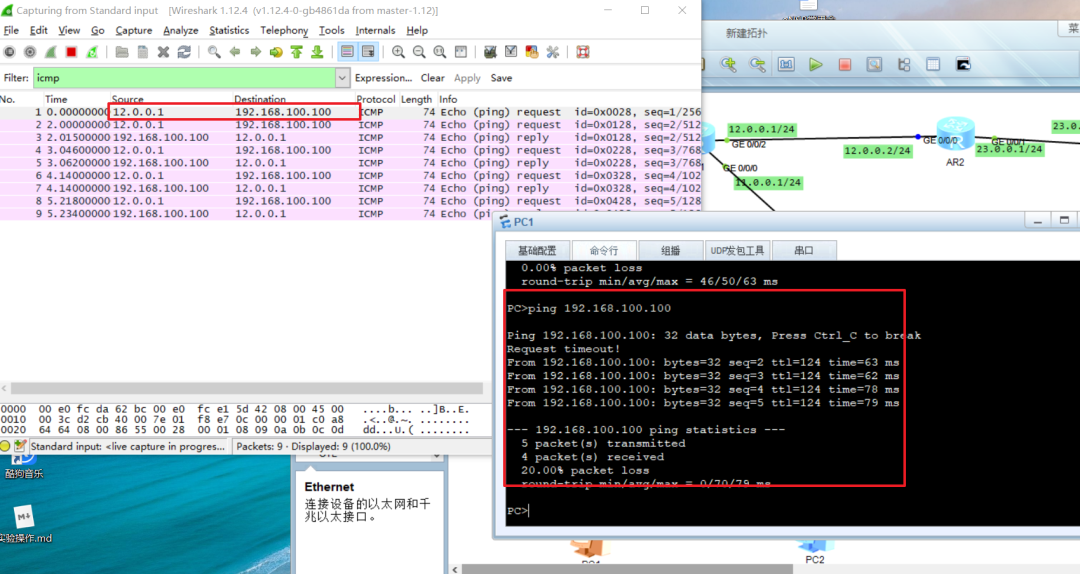
第四个配置:
R3配置
配置思路:
静态PAT不需要使用ACL,直接在接口上配置私网转公网的地址,且公网地址不要与其它公网地址冲突,自定义。
sys#进入系统模式 Entersystemview,
returnuserview
withCtrl+Z. [R3]intg0/
0/
0#进入接口g0/
0/
2 [R3-GigabitEthernet0/
0/
0]natserverprotocoltcpglobal
23.0
.0
.5
21inside
192.1
68.200
.200#在接口上配置私网转公网的ip地址 [R3-GigabitEthernet0/
0/
0]disnatserver#查看natserver NatServerInformation: Interface:GigabitEthernet0/
0/
0 GlobalIP/Port:
23.0
.0
.5/
21(ftp) InsideIP/Port:
192.168
.200
.200/
21(ftp)
Protocol:
6(tcp) VPNinstance-name:---- Aclnumber:---- Description:---- Total:
1 [R3-GigabitEthernet0/
0/
0]q#返回
配置服务器server1

第四个需求验证:
在AR2上使用server1的公网地址,可以完成登录
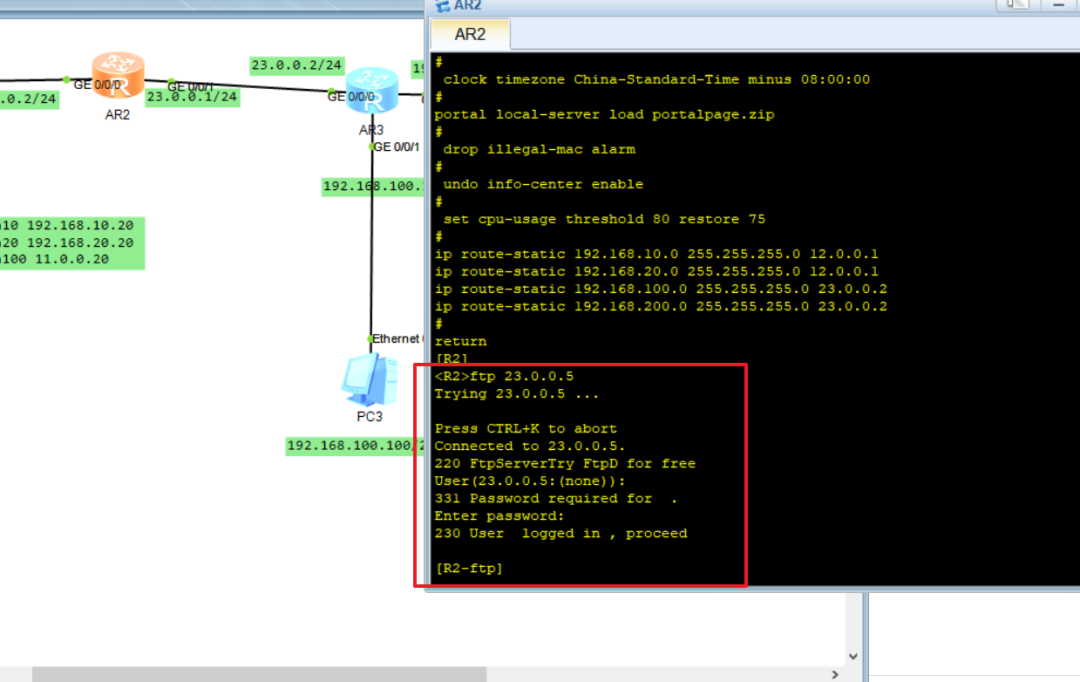
在clent1上可以远程登录FTPserver1的目录。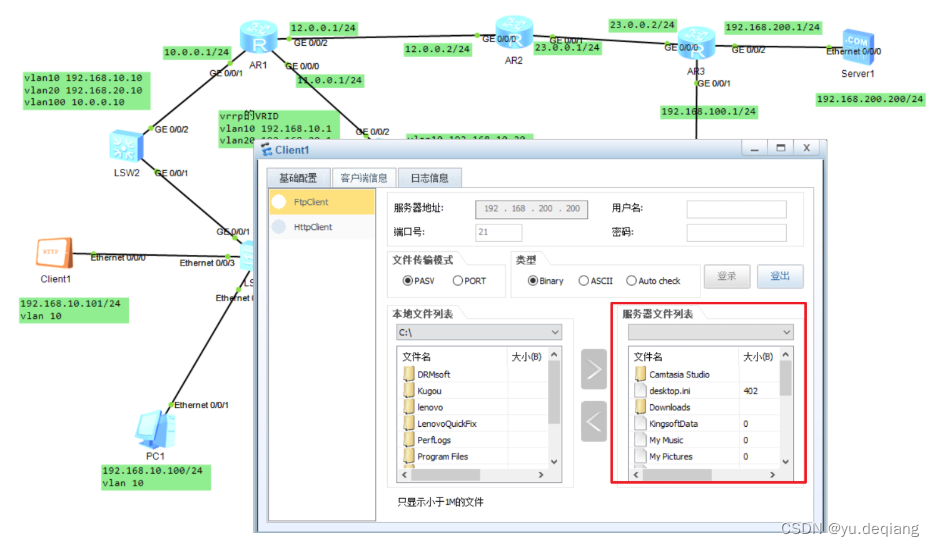



























 返回顶部
返回顶部